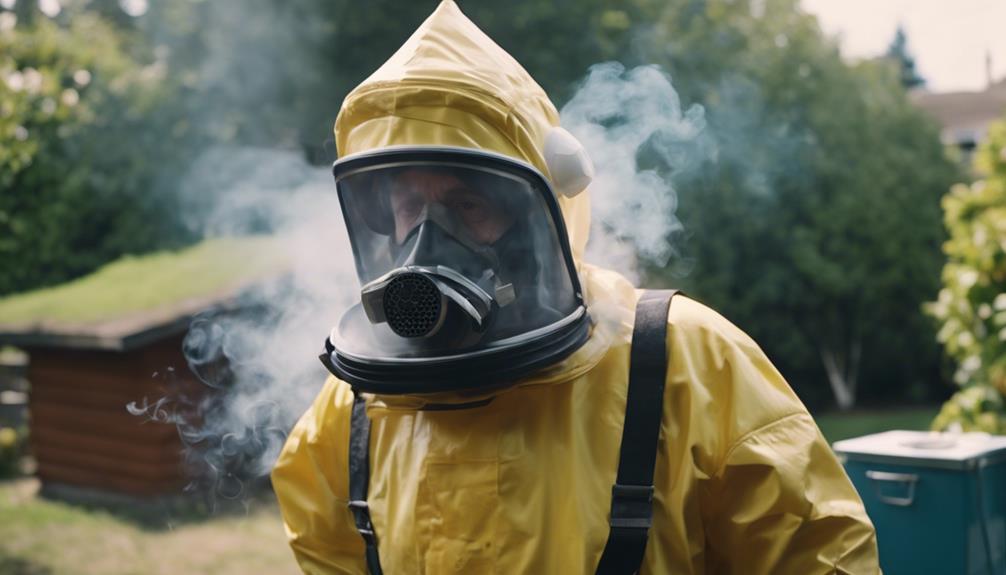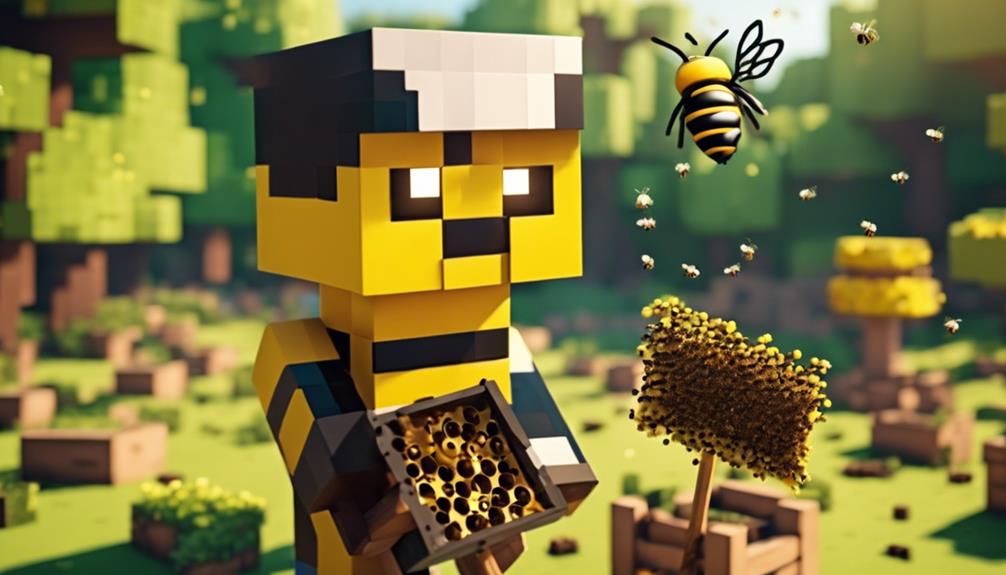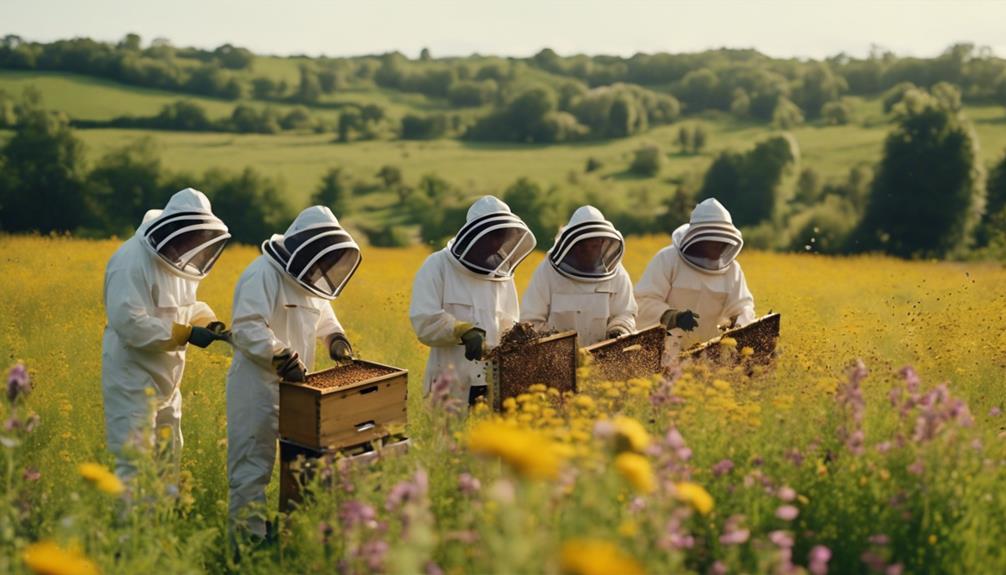When smoking bees at home, it’s important to prioritize safety and the well-being of both the bees and the beekeeper. Opt for natural materials like wood pellets or pine needles as safe fuels to produce gentle, cool smoke that calms the bees and masks alarm pheromones. To light the smoker properly, ignite it with newspaper or pine needles, maintaining a hot fire for effective smoke. Keep the smoker lit by adding fuel gradually and monitoring the smoke’s color and temperature.
Remember, a well-maintained smoker guarantees a relaxed hive environment and effective hive management. Mastering the art of smoking bees is not just about getting the process right; it’s about creating a peaceful coexistence with our buzzing buddies.
Main Points
- Use dry, cool-burning materials like pine needles for smoke.
- Start the smoker with quick-burning materials for easy ignition.
- Maintain steady smoke by adding slower-burning fuel.
- Avoid startling bees with proper smoking techniques.
- Keep the smoker lit by regularly adding fuel and oxygen.
Importance of Bee Smoker
Highlighting the significance of a bee smoker in beekeeping, we emphasize its role in ensuring the safety and efficiency of hive inspections. When beekeepers approach a hive, the buzz of activity can be quite intense. That’s where the bee smoker comes in – emitting a gentle stream of smoke that calms the bees and masks any alarm pheromones that might trigger defensive behavior.
This simple tool helps create a more relaxed environment for both the bees and the beekeepers. The smoke tricks the bees into thinking there may be a forest fire, prompting them to gorge on honey in preparation to flee. This distraction makes the bees less likely to sting, allowing beekeepers to work on the hive with reduced risk and disturbance.
It’s truly fascinating how a little smoke can make such a big difference in hive management.
Safe Fuels for Smoking Bees
Using safe fuels is essential for the well-being of the bees and the beekeeper when smoking bees at home. Opt for natural materials like wood pellets, pine needles, burlap, and dried leaves to create a calming smoke that doesn’t harm the bees.
Avoid toxic fuels with chemicals like bleach, dyes, glues, or pesticides to maintain a harmonious beekeeping environment.
Bee Smoker Fuel Types
We prefer using natural fuels like wood pellets, pine needles, and eucalyptus leaves for smoking bees at home. These safe fuels not only produce a gentle, cool smoke that calms the bees but also help maintain a healthy environment for our buzzing friends.
Avoiding toxic fuels containing bleach, dyes, plastics, or synthetic chemicals is vital to guarantee the well-being of the bees and the quality of the honey they produce. When selecting fuel for your bee smoker, be mindful of potential harmful chemicals that may be present in modern burlap and twine.
Making the right choice in fuel not only aids in effective smoke production but also contributes to a sustainable and safe beekeeping practice.
Best Fuels for Bees
To guarantee the well-being of bees and the quality of honey production, choosing safe fuels like burlap, wood pellets, pine needles, and eucalypt leaves is essential when smoking bees at home. These fuels burn clean and produce a gentle smoke that calms the bees without harming them.
It’s important to steer clear of toxic fuels containing bleach, dyes, glues, pesticides, plastic, or synthetic materials, as these can be harmful to the bees and contaminate the honey. By selecting the appropriate fuel, you not only safeguard the health of the hive but also the effectiveness of the smoke in keeping the bees tranquil during inspections.
Lighting the Smoker Properly
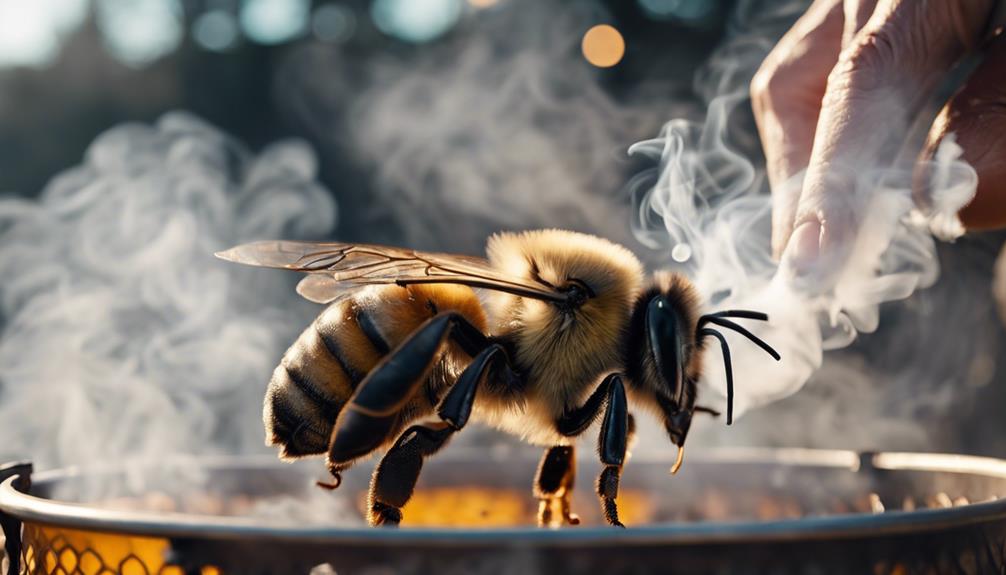
Using a small amount of newspaper or pine needles, ignite the smoker to begin the process of lighting it properly. To light my smoker effectively, I establish a hot fire by starting with these quick-burning materials. This initial burst of flames helps establish a good base before adding slower-burning fuels.
Once the fire is going, I compact the burning materials inside the smoker to limit oxygen and produce cool smoke. It’s crucial to maintain the smoker’s flame by adding more fuel and oxygen as needed during beekeeping tasks.
Maintaining Smoke Production
To guarantee a continuous and effective supply of smoke during beekeeping tasks, it’s vital to maintain airflow in the smoker steadily. Keeping the smoker lit and producing cool smoke requires attention to detail. Here are some essential tips:
- Add fuel gradually to keep the smoker going.
- Monitor the color and temperature of the smoke to make sure it remains cool.
- Clear any debris or clogs from the smoker nozzle for efficient smoke output.
Impact on Comb Honey Production
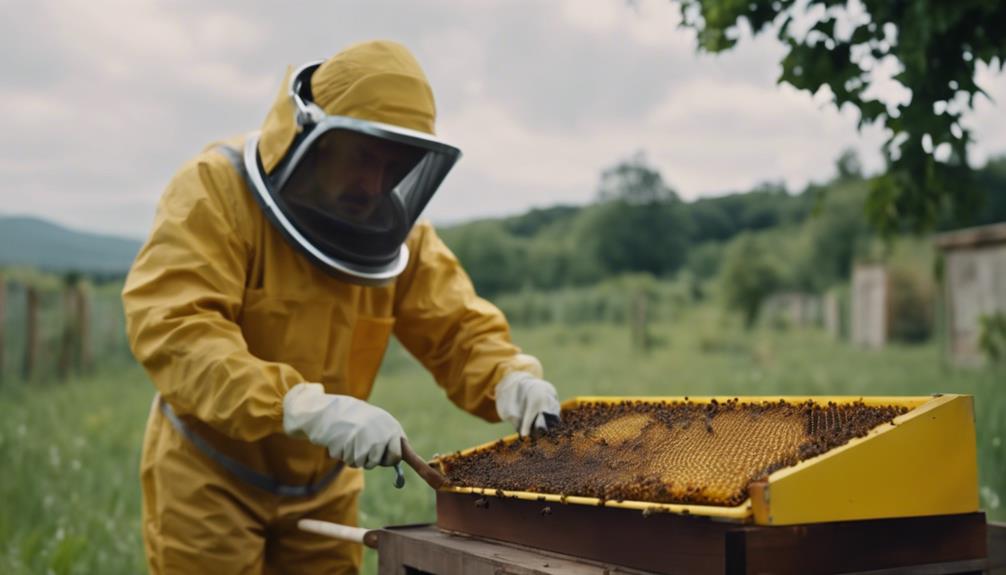
When smoking bees around comb honey, it’s important to take into account the impact on beeswax quality and honey flavor. The smoke can affect the taste and appearance of the honeycomb, influencing the overall product.
Beekeepers need to be mindful of minimizing smoke use to prevent bees from damaging capped cells and compromising the quality of the honey.
Beeswax Quality
Examining beeswax quality is essential for guaranteeing the production of high-quality comb honey that meets market standards. High-quality beeswax ensures the creation of clean, white comb honey with a delightful taste. Impurities or contaminants in beeswax can significantly impact the overall quality and marketability of comb honey.
- Beeswax quality directly influences the appearance and flavor of comb honey.
- High-quality beeswax guarantees clean, white comb honey with a pleasant taste.
- Impurities in beeswax can decrease the quality and market value of comb honey.
Regularly checking and maintaining beeswax frames are important for ideal comb honey production. Beeswax not only serves as a structural component in comb construction but also plays an essential role in honey storage.
Honey Flavor
Examining the flavor profile of honey is essential in understanding its impact on the production of comb honey. When smoking bees, there’s a risk of harm to the honey flavor. Bees, when exposed to smoke, might inadvertently rip open capped cells, potentially compromising the integrity of the comb honey. Balancing the use of smoke is vital to prevent altering the honey’s taste.
It’s important for us, as beekeepers, to be mindful of how smoking can affect the final product. By carefully managing the smoking process, we can maintain the quality of comb honey while ensuring that the unique and delightful flavor of honey remains intact. Remember, a gentle touch and a watchful eye can go a long way in preserving the essence of this sweet treat.
Fire Safety Measures
To guarantee safe practices when smoking bees at home, always have a fire extinguisher or water source readily available for immediate use in case of emergencies. When dealing with fire, safety is paramount.
Here are some essential fire safety measures to keep in mind:
- Confirm the smoker is placed on a non-flammable surface to prevent accidental fires.
- Never leave a lit smoker unattended and always extinguish it properly after use.
- Use caution when handling hot smoker components to avoid burns or accidental fires.
Environmental Responsibility
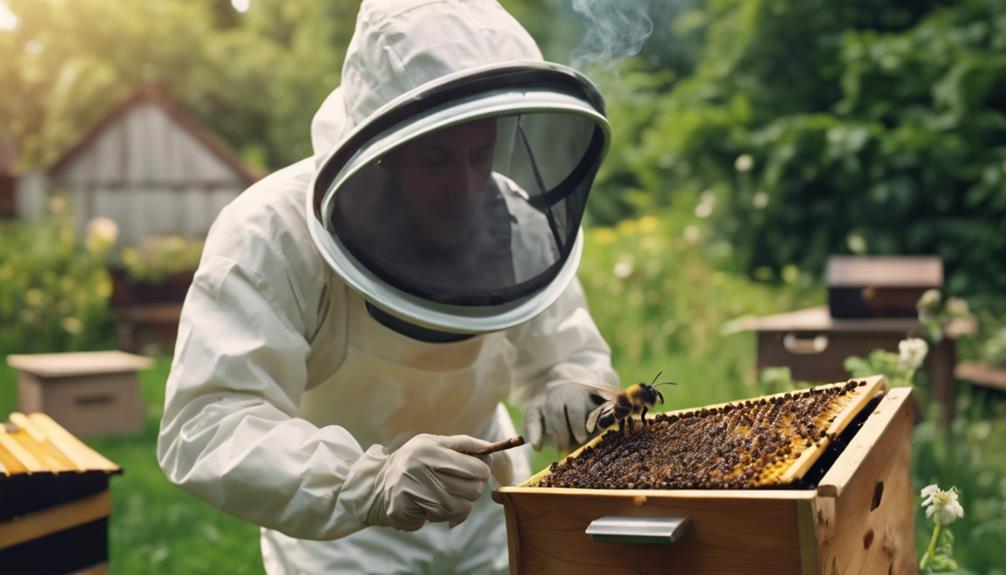
In regard to smoking bees at home, we must prioritize environmental responsibility. Utilizing sustainable materials for smoker fuel can lessen our impact on the environment.
Bee-Friendly Smoking Methods
In promoting environmental responsibility in beekeeping practices, we prioritize using natural, bee-friendly fuels like pine needles and wood pellets in our smokers to guarantee the well-being of our bees.
When it pertains to bee-friendly smoking methods, here are some key points to take into account:
- Use natural materials: Opt for pine needles, wood pellets, or dried leaves to produce cool smoke that won’t harm your bees.
- Avoid synthetic substances: Steer clear of synthetic materials, bleached paper, or plastic as smoker fuel to safeguard the health of your bees.
- Choose sustainable sources: Prioritize environmentally responsible choices by selecting sustainable fuel sources for your smoker, whether from your property or eco-friendly options.
Minimizing Air Pollution
Minimizing air pollution in beekeeping practices involves selecting organic, natural materials for smoker fuel to reduce harmful emissions. When smoking bees at home, opt for dried leaves or untreated wood shavings as fuel sources to keep the air clean and free from toxic fumes. By choosing sustainable fuel options, you not only protect the bees but also the environment.
Sustainable fuel choices guarantee that your beekeeping activities have minimal impact on air quality. Remember to properly extinguish the smoker after use to prevent unnecessary smoke emissions. Being mindful of the fuel you use and how you dispose of ash and debris demonstrates your commitment to responsible and environmentally friendly beekeeping practices.
Let’s keep the air clear and the bees buzzing happily!
Sustainable Beekeeping Practices
Promoting environmental responsibility through sustainable beekeeping practices is essential for preserving ecosystem health and biodiversity.
When it pertains to sustainable beekeeping, there are key practices to take into account:
- Minimizing Environmental Impact: Sustainable beekeeping involves reducing the use of chemicals and adopting natural hive management techniques.
- Supporting Biodiversity: Planting bee-friendly flora and avoiding harmful chemicals not only benefit bees but also contribute to a healthier environment.
- Integrated Pest Management: By utilizing integrated pest management strategies, beekeepers can minimize the need for synthetic treatments, promoting a more sustainable approach to hive maintenance.
These practices not only benefit the bees and the environment but also help create a more resilient ecosystem for future generations.
Guidelines for Beekeeping Practices
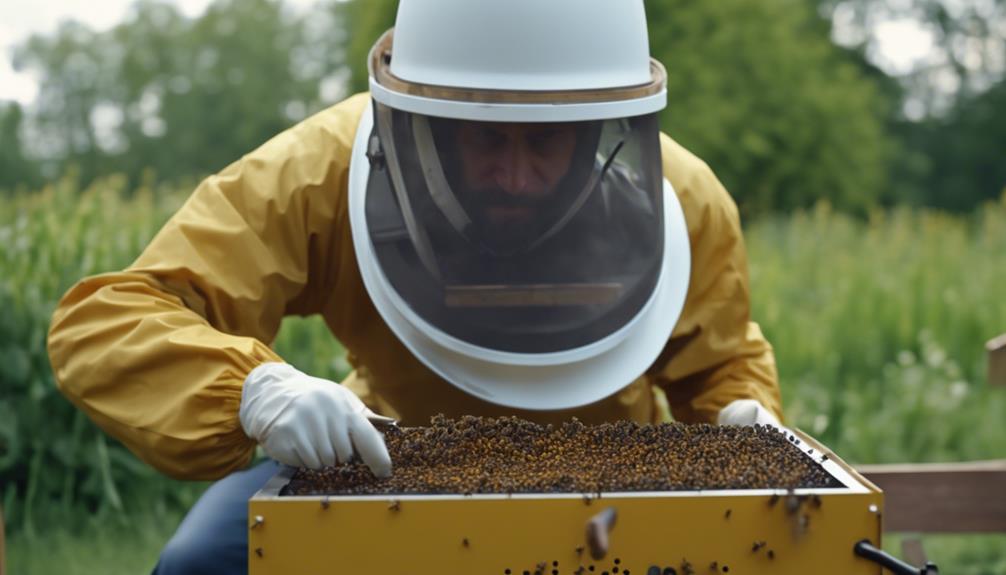
For successful and responsible beekeeping practices, prioritize the proper utilization of a purpose-made bee smoker equipped with essential features. The smoker, fueled with materials like wood pellets or pine needles, produces cool smoke vital for calming bees during hive inspections. When lighting the smoker, use quick-burning materials and guarantee a steady supply of fuel and oxygen for best smoke generation.
Remember, it’s best to refrain from smoking bees when collecting comb honey to maintain its natural flavor and appearance. Additionally, practice fire safety by having a water-filled bucket nearby for emergencies and always extinguish the smoker properly to prevent accidental fires.
Preventing Accidents
To prevent accidents when smoking bees at home, always have a fire extinguisher nearby. Proper ventilation is crucial to avoid smoke inhalation risks. Keep flammable materials away from the smoker to reduce fire hazards. Remember to use a stable surface for the smoker to prevent accidental tipping or falling.
Regularly inspect and maintain the smoker to prevent malfunctions that could lead to accidents. Safety should always be the top priority when engaging in beekeeping practices. By following these simple guidelines, you can enjoy the process of smoking bees while minimizing potential risks.
Be mindful of your surroundings and take proactive measures to guarantee a safe and enjoyable beekeeping experience.
Tips for Effective Bee Smoking
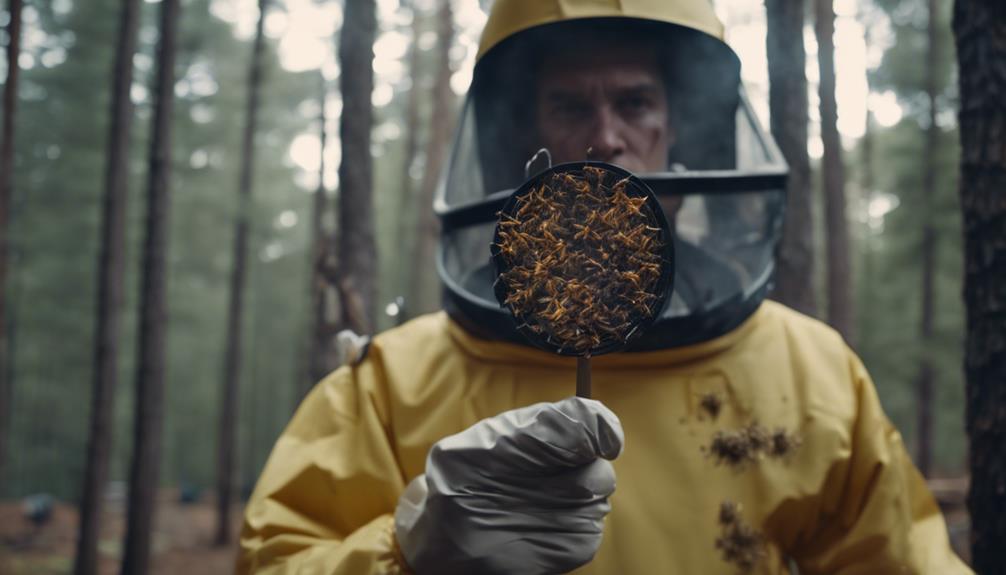
When smoking bees at home, choose dry, cool-burning materials like pine needles or wood pellets for safe and effective beekeeping practices.
Light the smoker first with quick-burning materials and then add slower-burning fuel to maintain a steady smoke.
It’s important to make sure the smoker produces cool smoke to calm bees without causing harm.
As a beekeeper, practicing proper smoking techniques is key – gently puff smoke around the hive entrance before opening to avoid startling the bees.
Remember to regularly add fuel and oxygen to keep the smoker lit, creating a calm environment for your beekeeping activities.

Hello! My name is Noel Calvin. I graduated from UCLA and now work as a writer at Launch Ninjas. I write blog posts that inspire and guide our readers in their entrepreneurial pursuits. I live in Pleasantville, NJ, with a peaceful yet lively atmosphere that inspires me.
Writing stories is more than just a job for me. It allows me to share my observations and satisfy my curiosity about the world. I combine my analytical skills with creative enthusiasm to delve into technology trends and startup stories. But my life isn’t limited to screens and keyboards. I value loyalty, passion, and a touch of old-fashioned charm, which I infuse into every narrative I create.
I love spending time in my garage, jamming with my band when I’m not writing. Playing the guitar and singing bring me immense joy. I also enjoy capturing ordinary and extraordinary moments through my camera lens and exploring new culinary adventures that excite my taste buds. I’m always seeking new experiences.
My family is very important to me. Joyful Sunday brunches filled with laughter and intense board game nights keep me grounded, reminding me of life’s simple pleasures.
In my world, every moment is an opportunity for discovery. Every discovery is a story worth sharing, whether a heartfelt moment at home or the pulse of technological innovations. Join me as I navigate through life, one blog post, one guitar strum, and one heartwarming family dinner at a time.
